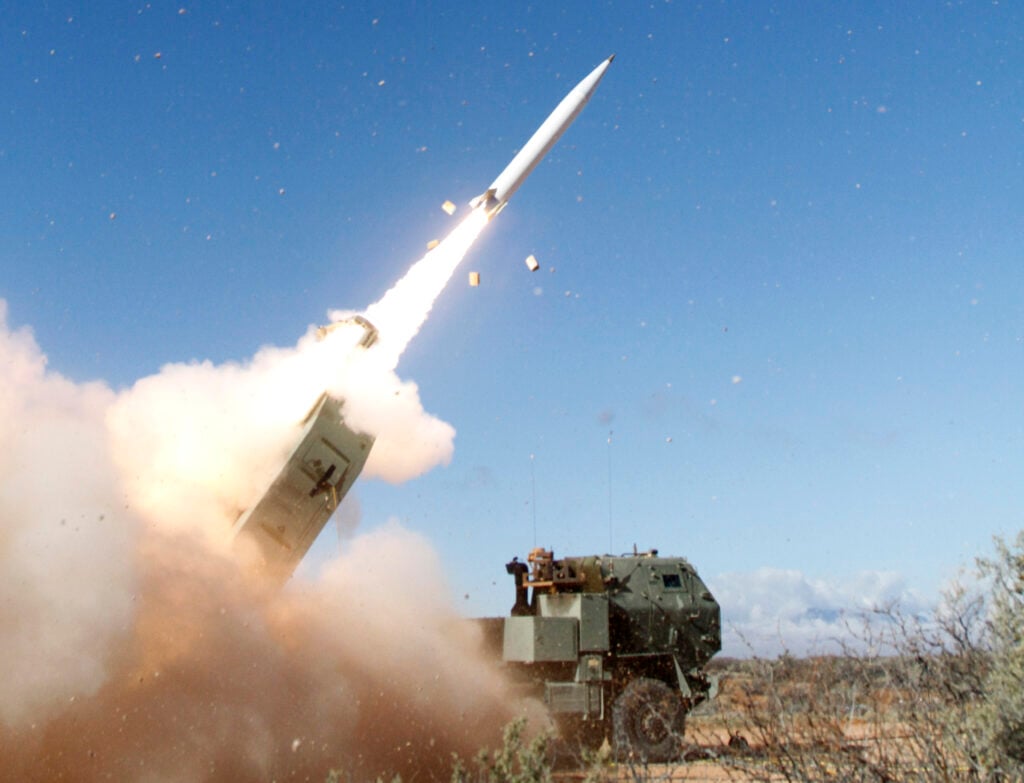
Lockheed’s prototype Precision Strike Missile (PrSM) fires from an Army HIMARS launcher truck
WASHINGTON: Service rivalries over roles and missions are coming to the fore as DoD and Congress begin to assess what to build for all-domain operations — with a dust-up looming over whether the Army or the Air Force should make platforms for taking out over-the-horizon targets.
Air power supporters argue that the Army’s top-priority Long-Range Precision Fires program, which aims to rebuild the artillery with new long-range cannons and surface-to-surface missiles to hit far-way ground targets, is stepping over traditional service boundaries.
“It’s ridiculous, to be quite candid. It is encroachment on roles and missions,” Dave Deptula, a retired Air Force lieutenant-general and dean of the Mitchell Institute, says. “The fact of the matter is the services need to adhere to their core competencies. And the United States Army reaching out to develop weapon systems that operate at thousand-mile range truly is encroachment.”
While top Air Force officials, including outgoing chief of Staff Gen. David Goldfein, have downplayed potential roles and missions clashes by citing the benefit of having overlapping capabilities, Deptula argues that tough choices are going to soon become imperative due to downward budgetary pressures stemming from the COVID-19 pandemic.
“While some people have said: ‘well, you know, it’s nice to have a variety of different capabilities’ — well, sure, in a world where you’ve got unlimited budgets,” he said yesterday, somewhat sarcastically.
Speaking at a webinar to promote the Mitchell Institute’s new “cost-per-effect” concept for assessing the value of weapon systems as part of a joint, all-domain force — a concept that is being backed by the Senate Armed Services Committee — Deptula stressed that military leaders are going to need to show “discipline” in making trade-offs.
Leaders have to keep services in their lanes, he said, but at the same time DoD needs to stop “thinking so myopically” at weapons as stand alone systems. DoD and military leaders need to “begin looking at capabilities across the entire Department of Defense enterprise. Otherwise, we’ll keep killing favorable options and maintaining lesser alternatives, because the bureaucracy does not reflect how we actually operate in the real world.”
Brig. Gen. David Harris, the new head of Air Force Warfighting Integration Capability (AFWIC), said the bottom-line issue is “How do we synchronize all these effects into one cohesive force package to move forward?”
For example, Harris said, the frustrating part is that how those decisions are currently being made is “inconsistent” — pointing to the fact that while the Air Force is divesting of A-10 Warthog close ground support aircraft, “the Army would be looking at getting the next-generation Apache helicopter, whatever it is when done.”
Mitchell Executive Director Douglas Birkey contended that there wasn’t any effort to compare the usefulness of the A-10 versus the expensive Apache, even though the A-10 is more lethal and survivable.
“Maybe this is a case to start developing something at a joint level where we have a joint warfighting integration capability, where we can look across service scope or look across services, and to see exactly what we’re doing so we’re not redundant, and we reduce some of the inefficiencies that are in there,” Harris added.
The tricky part of dealing with judging technology and new weapon systems for joint all-domain operations — especially with the modern software that will allow constant, inexpensive upgrades that is at the center of the Air Force’s Advanced Battle Management System (ABMS) — will be figuring out costs, Harris explained. This is because future weapon systems will constantly be evolving, with software patches and hardware/software pieces being swapped out on a regular basis.
“It’s a different mindset toward an acquisition approach,” he said.
Bill LaPlante, senior vice president for MITRE Corporation’s National Security Sector unit and former head of Air Force acquisition, said the trick to ensuring that rapidly iterating systems continues to meet real-world requirements is to keep operators and developers working together to make cost and capability trade-offs. It also involves breaking down the development plan into little bits and doing those trade-offs a long the way.
At the same time, he said, there needs to be flexibility to manage research and development across a “portfolio” or products and programs. (As Breaking D readers know, Air Force acquisition czar Will Roper is also a fan of the portfolio approach already in use by the DoD’s Strategic Capabilities Office that he founded.)
“If you manage the program portfolio approach across the family across the kill chain, the operators together with the developers at increment of a sprint almost, as you learn more you can adjust the requirements, and the cost. In fact to hold [cost] constant and not see what you need to do is actually foolish,” Laplante explained. “But you have to be strong, knowing that you’re not going to know everything about the cost of the capability and you’re going to have to trust people to trade them as they move along.”
Harris said that while making cost assessments for systems making up a truly joint force is complicated, the attributes such systems will require, and that must remain as constant variables in any type of assessment of value, can be narrowed down to three: “more lethal, more survivable and better connected.” The next step, he said, is to then war-game the systems as part of a larger force design to shake out their functionality.
He stressed that that it is important that DoD figure out how to handle these sticky issues, because Russia and China are already beginning to exploit multi-domain operations faster than the US military.
“It’s something we need to pay close attention to, and something we need to monitor closely,” he said.






















